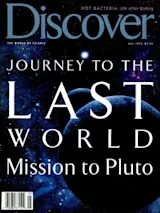Right now Jupiter utterly deserves its ancient moniker as king of the gods, at least during the hours of the night. Until Venus proclaims the dawn, the gaseous Goliath is the brightest star in the heavens, its creamy dazzle a lighthouse beacon in the southern sky. Unfortunately, though, this is its final season of prominence for a while. Jupiter won’t be this high again until 1998. Until then the solar system’s largest planet will hug the southern horizon, in the low part of its 12-year orbital path across our sky.
Jupiter’s so conspicuous now because it’s relatively close to us, a situation that recurs every 13 months when our faster-moving Earth catches up with the lethargic giant. As our two worlds pass, Jupiter seems to slip backward like a truck overtaken on the highway. Such retrograde motion was as bewildering to the ancients as programming a VCR is to us. ...














